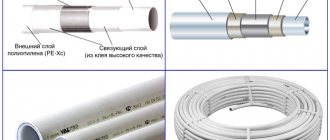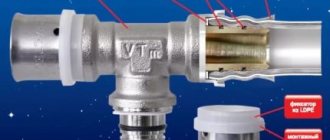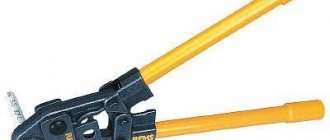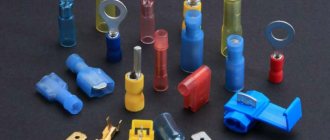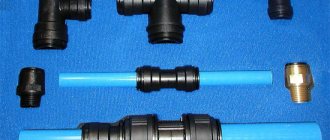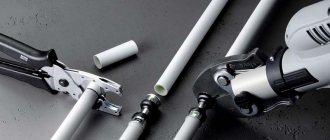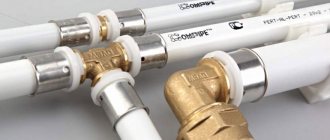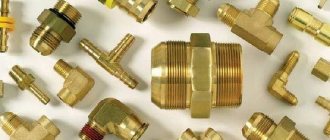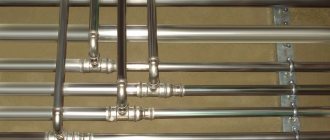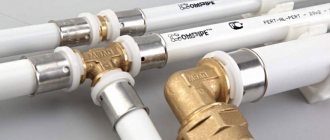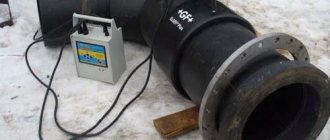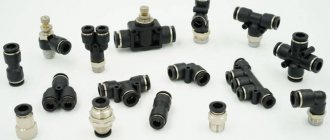The connection of metal-plastic pipes is made using compression fittings for clamping and their analogues for crimping. Installation of pipelines in both cases does not require sophisticated equipment or highly qualified specialists.
The first method is easier to implement, but not as reliable. But press fittings for metal-plastic pipes make it possible to create a durable system with minimal risk of rupture.
Let's figure out what types of connecting elements are on sale, how to choose the right press fitting and install it.
What are press fittings
Since metal-plastic pipes cannot be welded, their connection is carried out using additional installation parts - fittings.
There are two types of connections for metal-plastic communications: detachable and permanent.
- For a collapsible joint, fittings with a union nut are used, which acts as a press. Such parts are called compression parts.
- The second type of fittings is used when installing permanent structures. These are parts without threads. Instead of a nut, a steel sleeve plays the role of a press. During installation, the sleeve is deformed, and it becomes impossible to return it to its original shape.
Consequently, when installing metal-plastic pipes, two types of press fittings are used:
- crimping;
- sliding
The operating principle of these parts is the same. The difference lies in the installation technology. You will need different tools for the job.
Press fittings for metal-plastic communications are made of brass or stainless steel. Brass parts are slightly more expensive, but preferable to steel ones. Steel press fittings may be subject to corrosion processes in the future. With brass, this is excluded (subject to the installation technology).
Note! There are aluminum press fittings on the plumbing market. They are not suitable for connecting metal-plastic pipes, since the metal is too soft and will not compress the pipe with the necessary force.
You can distinguish low-quality products not only by price, but also by the weight of the part. Aluminum press fittings are significantly lighter than fittings made of brass or steel.
Installation and replacement rules
Unfortunately, it is impossible to replace the press fitting after it has been crimped. You can only cut it, throw it away, lengthen the metal-plastic pipe using a press connector, and press in a new part. Therefore, during installation you must be careful and follow all the rules for crimping connecting elements.
It is very important to draw a communication diagram in advance, then accurately determine the length of the segments - after all, after pressing, it will not be possible to disassemble the metal-plastic connection.
In the walls, pipelines are carried out in sleeves made of plastic pipes of larger diameter. The metal-plastic pipeline must move freely in the sleeve - this will protect the system during thermal expansion. Therefore, before starting work, it is necessary to punch holes in the walls, insert sleeves, cutting them flush with the wall. After installation, the holes with the sleeve can be covered with decorative overlays.
The fasteners must be installed near the fittings - this will reduce the movement of the metal-plastic pipe during heating and cooling and increase the reliability of the connection. It is better to use factory fastenings - clips or clamps.
Installation technology
Any installation begins with the preparation of workpieces. The pipe is cut strictly perpendicular to the required size, and the burrs are carefully and carefully removed with a file. If the metal-plastic pipe has become too flattened and has become oval, it is necessary to calibrate it using a calibrator.
A special tool – scissors or a pipe cutter – will help you avoid additional manipulations. Then thoroughly wipe the ends of the workpieces with a rag to remove dirt, dust, and plastic filings. It is advisable to remove the chamfer.
Crimping the workpiece in a press fitting:
- Disassemble the fitting and place the press sleeve on the end of the pipe.
- Insert the housing (inner liner) into the pipe with the sleeve until it stops.
- Insert the assembled workpiece into the press jaws.
- Bring the press handles together.
- When bringing the handles together, you need to apply sufficient force; you need to bring them all the way - then the connection will be of high quality. Remove the press - distinct ring marks from the pliers clamps will appear.
Crimping using a sliding connector:
- The end of the pipe is prepared.
- A sleeve is put on the end of the metal-plastic blank; the chamfer of the sleeve should be on the side of the end of the pipe.
- The sleeve near the end of the pipe is flared with a special device.
- The pipe is put on the fitting body, and the sleeve is moved further from the edge of the pipe.
- The half-assembled assembly is inserted into a special device.
- Using the device, the sleeve is pushed onto the fitting.
Advantages of a permanent connection
At first glance, a permanent joint may seem less attractive than a detachable joint. After all, a section of the pipeline cannot be repaired if necessary, but will have to be replaced completely.
We recommend that you read: Types of steel fittings and features of their installation
However, in the case of metal-plastic pipes and press fittings, everything is exactly the opposite - these connections are so strong that they do not require repair.
Advantages of permanent connection:
- High reliability. The connection can be operated at a pressure of 10 atm.
- High temperature resistance. The press joint can withstand any temperature load permissible during the operation of metal-plastic.
- Anti-corrosion resistance.
- Possibility of operation in “closed” mode. The press connection can be embedded in walls or floors. It does not require maintenance or repair.
- Easy to install. Installation of press fittings does not require expensive tools or special skills.
- The price of the parts is comparable to compression fittings, and often lower.
Note! Communications on press fittings have a service life equal to the “lifetime” of the metal-plastic pipe itself.
Pipe soldering
Let's consider connecting pipes using the soldering method:
- Using a hacksaw or sharp scissors that do not deform the plastic, cut the pipes at an angle of 90°. If you don't know how to cut a pipe at an angle, you need to read more information.
- If there are burrs on the end, carefully clean them off.
- Mark the depth of the soldering, i.e. measure a section of a certain length on the pipe to fit into the coupling or tee and draw a line with a marker. Remember that the length of immersion into the connecting element is directly dependent on the diameter of the products. The larger the pipes, the greater the soldering depth.
The algorithm of actions will change slightly if the pipes are reinforced. Then, before the soldering process, it is necessary to process the top layer of the tubular product, including aluminum foil, basalt or nylon fiber. Using a special tool, the required layer size can be easily removed
You need to pay special attention to carefully remove the foil. Even a slight excess of it on the pipe will negatively affect the tightness of the solder joint.
Further steps in the soldering process:
- Place a soldering iron with nozzles that are pre-selected according to the diameter of the pipes on a smooth and reliable surface.
- At the same time, a pipe and fitting are placed on the hot nozzle on both sides, moving it to the marking made with a marker.
- Heat the plastic for a certain time, which depends on the diametrical size of the pipes. For example, if the cross-section of the product is 20 mm, then 6 seconds are enough to heat up; if 32 mm - 8 sec.
- Then the elements are removed from the nozzle and ensure a strong fixation into each other. Never make any turning movements.
- To ensure strong adhesion of the joint, you need to wait 4-10 seconds. This time will be enough for the polypropylene to harden properly and obtain a permanent connection.
Part device
The design of press fittings for metal-plastic pipes is the same in the case of a crimping and tensioning version of the part. Fittings come in various purposes (for connecting pipes made of different materials) and configurations.
The part of the press fitting, which is intended for a metal-plastic pipe, consists of:
- housings with internal fitting;
- two o-rings on the fitting;
- dielectric gasket (on the fitting);
- external crimp sleeve.
Note! A dielectric ring gasket is needed to isolate two metals, aluminum and brass (or steel), from each other. If they come into contact in an aqueous environment, an electrolysis effect will occur. This will lead to rapid destruction of the joint.
Scope of application
Metal-plastic communications at press joints are used in any of the possible household pipelines:
- when installing water pipelines, including hot water;
- when installing a heating system with a working pressure of up to 10 atm;
- when installing heated floors;
- for hidden installation of electrical wires;
- when moving from one pipeline to another;
- when connecting pipes of different diameters.
On an industrial scale, metal-plastic pipes are used:
- for transporting liquids (food, in the chemical industry) with a working pressure of no more than 10 atm;
- for transportation of gases, including compressed air;
- to protect the power cable.
We recommend that you familiarize yourself with: Types and main characteristics of American pipes for polypropylene pipes
Limitations in the use of metal-plastic pipes include the need to dismantle communications in the future. For example, to change the configuration or add additional wiring.
Varieties
The range of press fittings is very wide. This allows you to select connecting elements for any joint, branch, or turn. Manufacturers produce a size range of parts for assembly that corresponds to the diameter of the pipe material.
Note! To create a strong connection, you should buy all communications material from one manufacturer.
Today there are no established uniform standards for sizes for fittings. Each production uses its own standard. A difference of half a millimeter can cause leakage in the future.
- Adapters. The parts are used when installing a linear transition: from diameter to diameter (more or less); from metal-plastic to plastic; from metal-plastic to steel.
- Details for wiring. These are tees, crosses. Corners and contours are rarely required when installing metal-plastic pipes, since the plasticity of the pipe material itself is used here. Fittings for wiring can combine the possibility of wiring and changing to another material or diameter. Such connecting parts are called combined.
- Couplings. Parts for connecting straight pipes of the same diameter.
- Shut-off fittings are taps, taps, valves that are installed to allow the flow of media to be adjusted. As a rule, shut-off valves are installed on a collapsible connection, but it is also possible to install press valves.
What tool can be used
The selection of special pliers includes both the simplest manual and more powerful hydraulic models. At home, when it is necessary to install or repair a pipeline only occasionally, the functionality of a manual design is quite sufficient. In terms of the quality of the joint created, if everything is done correctly and carefully, there will be no difference from professional devices
It is important to consider that all models are optimized for a specific diameter. There are tools that come with inserts
Then a lot depends on what set of inserts are supplied. Along with the simplest press tongs, there are also more advanced designs. So, if a tool is marked with the letters APC, this means that the device automatically monitors the reliability of the joint being formed. It is impossible to open the press until crimping is completed. The APS marking indicates that the pliers can not only adapt to different sizes of fittings, but also distribute the applied forces most accurately. But if OPS is written on the pliers, then the tool is equipped with stepped clamps and is therefore capable of multiplying the applied force.
